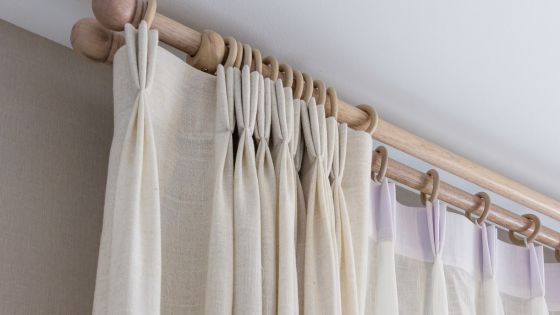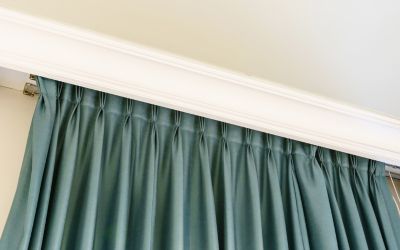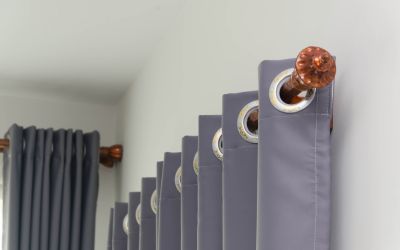Please wait...
Curtain Headings Explained
This entry was posted 02/08/2023

Selecting the ideal curtain heading can be quite a daunting task, with numerous options available. However, fear not! We've compiled some helpful tips to aid you in choosing the perfect curtain heading that will exude the style you desire.
Pencil Pleat
A Pencil Pleat curtain heading is a popular style of curtain heading used in window treatments. The term "pleat" refers to the folds or gatherings of fabric at the top of the curtain, which help create a neat and uniform appearance. The name "Pencil Pleat" comes from the resemblance of the pleats to tightly grouped pencil lines.
Here's how Pencil Pleat curtains are typically made:
-
Heading Tape: Pencil Pleat curtains have a special heading tape sewn onto the top edge of the curtain fabric. This tape contains multiple rows of tightly spaced cords or strings that can be pulled to create the pleats.
-
Gathering: To create the pleats, the cords in the heading tape are pulled and gathered together. The amount of gathering can be adjusted to control the fullness and appearance of the curtains.
-
Hooks or Rings: Once the curtain is gathered into pleats, it is hung using curtain hooks or rings, which are inserted through the loops in the heading tape.
-
Adjustment: Pencil Pleat curtains often come with a cord or cord-lock mechanism, allowing you to adjust the width of the curtain and customize the pleat spacing.
Pencil Pleat curtains offer a classic and timeless look, suitable for various interior styles. They provide a tailored and elegant appearance when hung and are compatible with a range of curtain rods or tracks. These curtains can be used with various fabric types, from lightweight sheers to heavier drapes, depending on the desired level of privacy and light control.
Double or Triple Pinch Pleat
A double or triple pleat curtain heading is an alternative style of curtain heading that offers a more luxurious and formal look compared to the Pencil Pleat. These headings are also known as "Pinch Pleat" headings. Instead of having tightly spaced and smaller pleats like in the Pencil Pleat, the Pinch Pleat headings feature larger, evenly spaced pleats that create a more structured and elegant appearance.

Here's how double or triple pleat curtain headings are typically made:
-
Fabric Preparation: The curtain fabric is cut to the desired width and length, taking into account the fullness required for the pleats.
-
Pleating: In double or triple pleat headings, the fabric is gathered into larger pleats at regular intervals. The pleats are formed by pinching the fabric together and then stitching it in place, hence the name "Pinch Pleat."
-
Buckram or Header Tape: To maintain the pleats' shape and structure, a stiffening material called buckram is often used. The buckram is inserted into the top of the curtain, between the layers of fabric, and secured in place. Alternatively, some curtains may use a header tape with multiple cords or strings to create the pleats.
-
Hooks or Rings: Like Pencil Pleat curtains, double or triple pleat curtains are hung using curtain hooks or rings, which are inserted through the pleats.
-
Adjustment: Some double or triple pleat curtains may also come with a cord or cord-lock mechanism to adjust the width of the curtains and control the fullness.
Double pleat curtains have two pleats per group, while triple pleat curtains have three pleats per group. The choice between double and triple pleats largely depends on personal preference and the desired level of opulence in the curtain's appearance. These pleated curtains are often used with medium to heavy weight fabrics to accentuate the formal and elegant drape. They are well-suited for formal living areas, dining rooms, and bedrooms where a more sophisticated and luxurious ambiance is desired.
Gathered 1" Tape or Cottage Pleats
Gathered 1" Tape and Cottage Pleats are two different curtain headings that both involve gathering the fabric to create a specific style of curtain.
Gathered 1" Tape:
-
-
Gathered 1" Tape is a curtain heading that uses a narrow tape, typically around 1 inch wide, sewn onto the top of the curtain fabric. The tape has strings or cords running through it. To create the gathered look, the cords in the tape are pulled, which gathers the fabric to form soft and even pleats. The gathered appearance can be adjusted to control the fullness of the curtains. This type of heading is relatively simple to achieve and offers a more casual and relaxed look compared to some other pleating styles. Gathered 1" Tape curtains are commonly used with lightweight fabrics and are suitable for informal settings like cottages, kitchens, and casual living spaces.
-
Cottage Pleats:
-
- Cottage Pleats are a specific style of pleating used in curtain headings. These pleats are wider and have a more relaxed and informal look compared to traditional pinch pleats. Cottage Pleats are created by folding the fabric into wide pleats and then stitching them at regular intervals to hold the pleats in place. The pleats are evenly spaced and create a casual, cottage-inspired appearance. Cottage Pleats are often used with lightweight to medium-weight fabrics and are well-suited for informal and country-style interiors.
Both Gathered 1" Tape and Cottage Pleats offer a relaxed and easy-going aesthetic that complements certain interior design styles. The choice between them depends on personal preference, the fabric being used, and the desired ambiance in the room where the curtains will be hung. These headings are suitable for achieving a comfortable and informal atmosphere in your living spaces. This style works wonders on lightweight curtains with a short drop, making it delightful choice for cottage kitchens or bedrooms. The cottage pleat heading can be used with either tracks or poles, allowing you to adjust the gathering to fit your window's width.
Eyelet
Eyelet curtains, also known as grommet curtains, are a type of window treatment with a distinctive heading style. These curtains feature metal rings or eyelets inserted into the fabric at the top, creating evenly spaced openings through which a curtain rod can be threaded. The eyelets are typically made of metal or plastic and are available in various finishes to complement different curtain designs.

Here's how eyelet curtains work and some of their characteristics:
-
Eyelet Heading: The top edge of the curtain fabric is reinforced with a band or strip of fabric to provide strength and stability. The eyelets are then attached to this reinforced strip, usually at regular intervals, allowing the curtain to be hung from the rod.
-
Easy Installation: Eyelet curtains are easy to install as you simply slide the curtain rod through the eyelets and hang the curtains in place. They can also be easily removed for washing or cleaning.
-
Modern Look: Eyelet curtains offer a contemporary and streamlined look, making them a popular choice for modern and minimalist interior designs. The pleats created by the eyelets are neat and uniform, adding a clean and stylish appearance to the curtains.
-
Natural Folds: When eyelet curtains are hung, the fabric naturally falls into gentle folds or waves between the eyelets, creating an elegant drape.
-
Fabric Choices: Eyelet curtains can be made from various fabrics, including sheer materials for a light and airy look, or heavier fabrics for better light and privacy control.
-
Curtain Rods: To hang eyelet curtains, you'll need a curtain rod with a diameter that fits through the eyelet rings. The curtain rod should have a smooth surface to allow the eyelets to slide easily.
Eyelet curtains are often used in living rooms, bedrooms, and other areas where a modern and sleek appearance is desired. They provide a practical and stylish window covering solution that can effortlessly enhance the overall decor of a room.
Its worth noting, eyelets can only be used with curtain poles and are not recommended for bay windows or in conjunction with valences or pelmets.
Tab Top Curtains Heading
A tab top curtain heading is a type of window treatment that features fabric loops, or tabs, sewn directly onto the top edge of the curtain panel. These tabs are used to hang the curtains from the curtain rod, creating a casual and relaxed look. Tab top curtains are popular for their simplicity and easy installation.

Here's how tab top curtains work and some of their characteristics:
-
Tabs: The tabs are typically made of the same fabric as the curtain itself or can be made from contrasting or coordinating materials for a decorative touch. They are usually evenly spaced across the top of the curtain panel, with each tab forming a loop that allows the curtain rod to be threaded through.
-
Hanging: To hang tab top curtains, you simply slide the curtain rod through the loops created by the tabs. The curtains can then be adjusted along the rod to achieve the desired level of fullness and appearance.
-
Relaxed Look: Tab top curtains provide a relaxed and casual look, making them suitable for various interior styles, including bohemian, coastal, and country-themed decors.
-
Lightweight Fabrics: Tab top curtains are often made from lightweight fabrics like cotton or linen, as heavier fabrics may cause the tabs to bunch up or not hang properly.
-
Limited Adjustability: Unlike some other curtain headings, tab top curtains don't offer much adjustability in terms of pleating or fullness. The appearance of the tabs remains relatively constant, providing a more uniform look.
-
Kid-Friendly: Tab top curtains are a popular choice for kids' rooms because they are easy to open and close, and there are no hooks or rings that children could potentially pull on.
Tab top curtains are an excellent option for spaces where a casual and easy-going ambiance is desired. They are often used in living rooms, bedrooms, and informal areas of the home. However, due to their simplicity and limited adjustability, they may not be the best choice for achieving a more formal or tailored look.
Wave Curtain Headings
A wave curtain heading is a modern and stylish type of window treatment that offers a sleek and uniform appearance. This heading style is also known as "wave pleat," "s-fold," or "ripple fold" heading. Wave curtains are becoming increasingly popular due to their contemporary look and ease of use.
Here's how wave curtains work and some of their characteristics:
-
Heading Tape: Wave curtains have a special heading tape sewn onto the top of the curtain panel. The heading tape contains evenly spaced pockets or channels, which help create the characteristic "wave" effect when the curtains are hung.
-
Special Track System: To achieve the wave effect, wave curtains require a specific track system designed for this heading style. The curtain track has gliders that fit into the pockets of the heading tape, allowing the curtains to smoothly and uniformly glide along the track.
-
Uniform Appearance: When wave curtains are hung, they form soft and continuous waves along the width of the curtain. The waves have equal spacing, creating a consistent and elegant look.
-
Easy Operation: Wave curtains are effortless to open and close, as they glide smoothly along the track. They are usually operated with a cord or wand, making them simple to adjust and position.
-
Fullness: Wave curtains have a fixed fullness, which means they maintain a consistent appearance whether they are fully open or closed. This is different from some other heading styles that offer more adjustability in terms of fullness and pleating.
-
Versatility: Wave curtains work well with various fabric types, from lightweight sheers to heavier drapes, offering options for light filtering and privacy control.
Wave curtains are a popular choice for modern and minimalist interior designs. They offer a clean and streamlined look that complements contemporary spaces. The uniform appearance of the waves adds an element of sophistication and elegance to any room. Due to the specialized track system required, wave curtains are often custom-made and may be more expensive than some other heading styles. However, their modern aesthetics and ease of use make them a preferred option for many homeowners seeking a chic and functional window treatment solution.
So, picking the right heading for your curtains is super important to nail the style and vibe you want in your space. First off, think about how you want your room to feel and look. If you dig a neat and budget-friendly finish, pencil pleats are the way to go for that contemporary or classic home charm. For a fancier touch that works in both modern and traditional spaces, try double or triple pinch pleats – they're timeless! Need something more casual and laid-back? Gathered 1" tape or cottage pleats are spot-on for a cozy cottage kitchen or bedroom. Want to be all cool and sleek? Eyelet curtains bring that sophisticated and modern flair, with soft and even pleats. Tab tops are great too if you're after a sleek style. And oh, for an effortlessly elegant look with a ripple effect, wave headings are ace, especially if you have big windows or a glassy wall. So, choose wisely, and let your curtains show off your home's true personality!
This entry was posted on 02/08/2023

